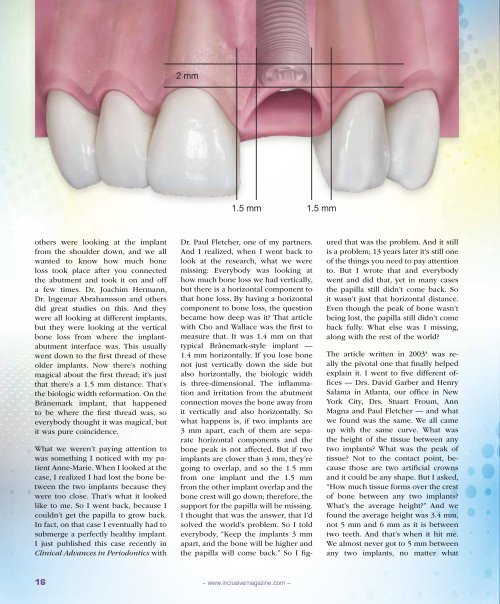PDF Download - Glidewell Dental Labs
PDF Download - Glidewell Dental Labs
PDF Download - Glidewell Dental Labs
You also want an ePaper? Increase the reach of your titles
YUMPU automatically turns print PDFs into web optimized ePapers that Google loves.
2 mm<br />
1.5 mm<br />
1.5 mm<br />
others were looking at the implant<br />
from the shoulder down, and we all<br />
wanted to know how much bone<br />
loss took place after you connected<br />
the abutment and took it on and off<br />
a few times. Dr. Joachim Hermann,<br />
Dr. Ingemar Abrahamsson and others<br />
did great studies on this. And they<br />
were all looking at different implants,<br />
but they were looking at the vertical<br />
bone loss from where the implantabutment<br />
interface was. This usually<br />
went down to the first thread of these<br />
older implants. Now there’s nothing<br />
magical about the first thread; it’s just<br />
that there’s a 1.5 mm distance. That’s<br />
the biologic width reformation. On the<br />
Brånemark implant, that happened<br />
to be where the first thread was, so<br />
everybody thought it was magical, but<br />
it was pure coincidence.<br />
What we weren’t paying attention to<br />
was something I noticed with my patient<br />
Anne-Marie. When I looked at the<br />
case, I realized I had lost the bone between<br />
the two implants because they<br />
were too close. That’s what it looked<br />
like to me. So I went back, because I<br />
couldn’t get the papilla to grow back.<br />
In fact, on that case I eventually had to<br />
submerge a perfectly healthy implant.<br />
I just published this case recently in<br />
Clinical Advances in Periodontics with<br />
Dr. Paul Fletcher, one of my partners.<br />
And I realized, when I went back to<br />
look at the research, what we were<br />
missing: Everybody was looking at<br />
how much bone loss we had vertically,<br />
but there is a horizontal component to<br />
that bone loss. By having a horizontal<br />
component to bone loss, the question<br />
became how deep was it? That article<br />
with Cho and Wallace was the first to<br />
measure that. It was 1.4 mm on that<br />
typical Brånemark-style implant —<br />
1.4 mm horizontally. If you lose bone<br />
not just vertically down the side but<br />
also horizontally, the biologic width<br />
is three-dimensional. The inflammation<br />
and irritation from the abutment<br />
connection moves the bone away from<br />
it vertically and also horizontally. So<br />
what happens is, if two implants are<br />
3 mm apart, each of them are separate<br />
horizontal components and the<br />
bone peak is not affected. But if two<br />
implants are closer than 3 mm, they’re<br />
going to overlap, and so the 1.5 mm<br />
from one implant and the 1.5 mm<br />
from the other implant overlap and the<br />
bone crest will go down; therefore, the<br />
support for the papilla will be missing.<br />
I thought that was the answer, that I’d<br />
solved the world’s problem. So I told<br />
everybody, “Keep the implants 3 mm<br />
apart, and the bone will be higher and<br />
the papilla will come back.” So I figured<br />
that was the problem. And it still<br />
is a problem; 13 years later it’s still one<br />
of the things you need to pay attention<br />
to. But I wrote that and everybody<br />
went and did that, yet in many cases<br />
the papilla still didn’t come back. So<br />
it wasn’t just that horizontal distance.<br />
Even though the peak of bone wasn’t<br />
being lost, the papilla still didn’t come<br />
back fully. What else was I missing,<br />
along with the rest of the world?<br />
The article written in 2003 4 was really<br />
the pivotal one that finally helped<br />
explain it. I went to five different offices<br />
— Drs. David Garber and Henry<br />
Salama in Atlanta, our office in New<br />
York City, Drs. Stuart Froum, Ann<br />
Magna and Paul Fletcher — and what<br />
we found was the same. We all came<br />
up with the same curve. What was<br />
the height of the tissue between any<br />
two implants? What was the peak of<br />
tissue? Not to the contact point, because<br />
those are two artificial crowns<br />
and it could be any shape. But I asked,<br />
“How much tissue forms over the crest<br />
of bone between any two implants?<br />
What’s the average height?” And we<br />
found the average height was 3.4 mm,<br />
not 5 mm and 6 mm as it is between<br />
two teeth. And that’s when it hit me.<br />
We almost never got to 5 mm between<br />
any two implants, no matter what<br />
16<br />
– www.inclusivemagazine.com –

















